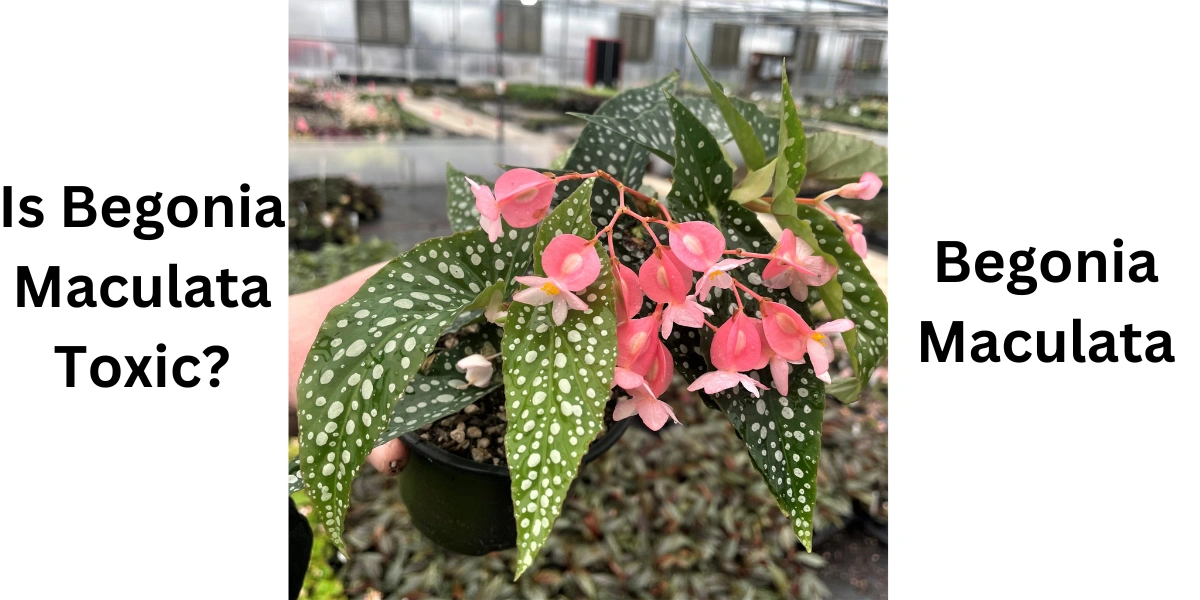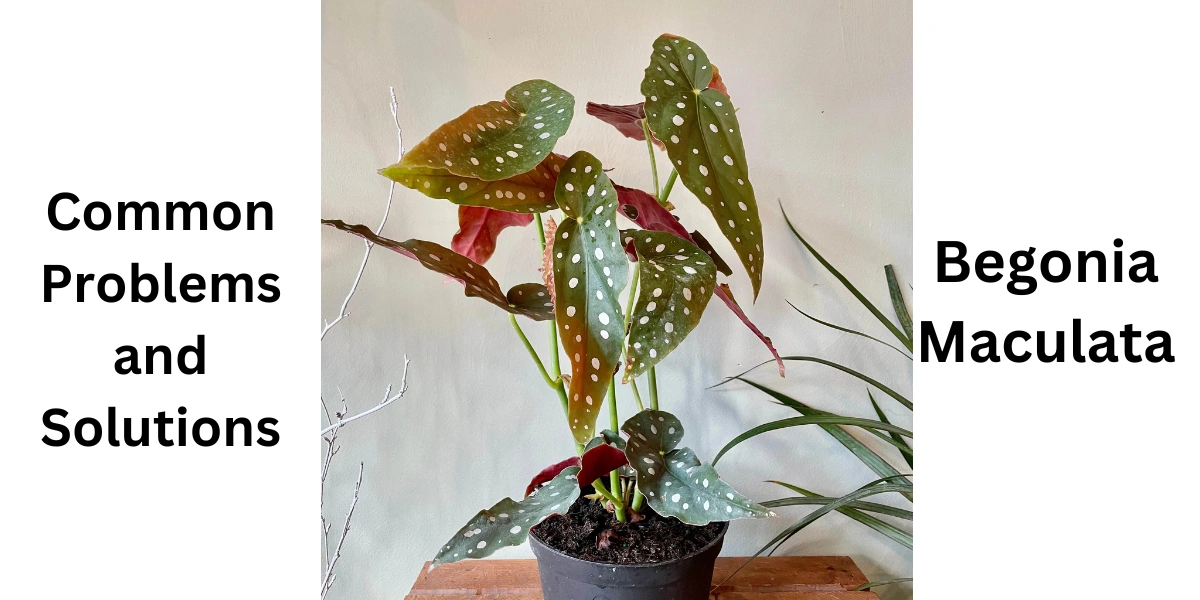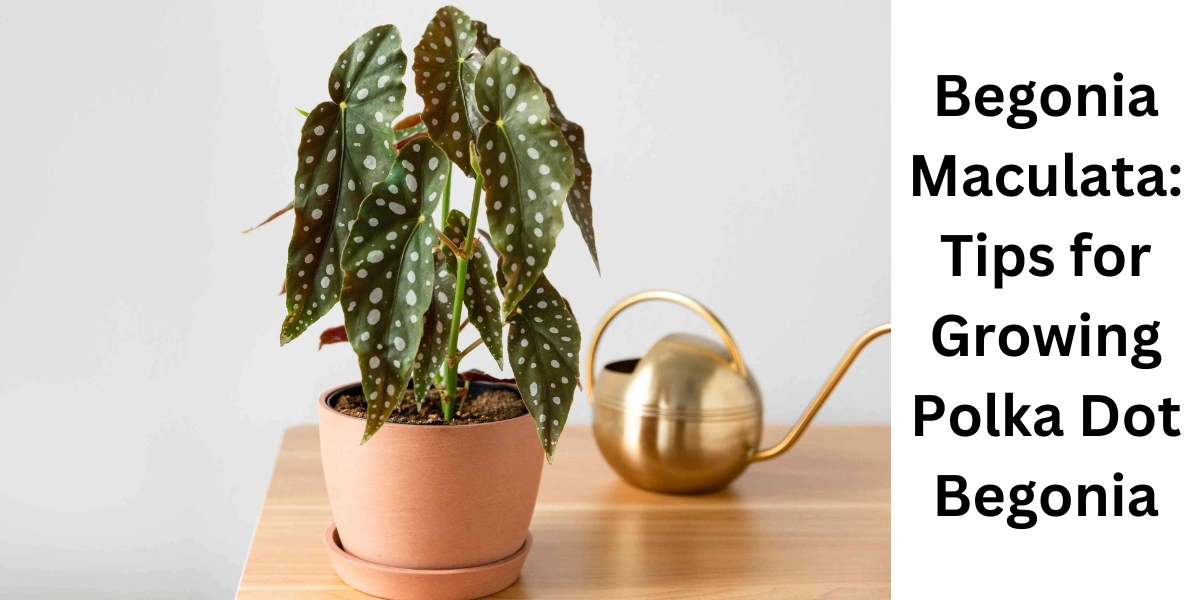Begonia Maculata: Tips for Growing Polka Dot Begonia
One of the most gorgeous houseplants you can discover is the lovely Begonia Maculata, sometimes referred to as the polka dot begonia. In my growing collection, it’s also one of my personal favorites! I fell in love with it after seeing a picture of it online at my favorite local nursery when I initially purchased it. I adore this houseplant’s quirky appearance, which is reminiscent of a plant from a Dr. Seuss book, as well as its stunning dark green leaves and the contrast of the silvery polka dots on them.
Begonia maculate, which I had already fallen in love with before purchasing it, never ceased to amaze me. I was thrilled to see it in bloom when my plant shop delivered it! It arrived with a dozen white blossoms, and even though it is now fall and winter, it has never ceased to amaze me in the finest ways. It has been producing amazing new growth at a steady pace. My begonia maculata constantly produces new leaves right when I’m feeling depressed about something as if it somehow knows when I need a pick-me-up.
I recall being shocked to see a brand-new leaf that I had no idea was coming, looking enormous and robust after only a few short days gone, when I returned home from a particularly trying road trip! I’ve just had this plant for approximately two months, yet already it’s produced two new leaves and bloomed twice. Its height has also almost doubled! I’m so pleased with my lovely polka-dot begonia, and it requires very little care.
Understanding Begonia Maculata
Origin and Overview
The Polka Dot Begonia is a part of the Begoniaceae family, a group of plants known for their ornamental qualities. Native to the subtropical and tropical regions of Brazil, this plant thrives in humid environments, making it ideal for indoor growing. The genus Begonia encompasses over 2,000 species, with Begonia Maculata being one of the most popular for its attractive and distinctive foliage. It is sometimes also referred to as “Wightii” or “Angel Wing Begonia” because of the shape of its leaves.
Distinctive Features
The main attraction of Begonia Maculata is its leaves. These have a deep green color with prominent silver or white spots, which gives them their unique polka-dotted appearance. The leaves are often large and elongated, with a smooth, glossy texture. Another interesting characteristic is the undersides of the leaves, which are typically a striking red color, adding another layer of beauty. The plant produces small white or pink flowers that grow in clusters, though they are often overlooked due to the plant’s more captivating foliage.
What Does Begonia Maculata Look Like?
Begonia Maculata, also known as the Polka Dot Begonia, features striking, asymmetrical leaves with deep green coloring on the upper side and silvery-white spots resembling polka dots. The leaves have a characteristic shape, being long and elongated with pointed tips. The underside of the leaves is a rich, reddish-brown color, adding to its visual appeal. The plant also produces small white or pink flowers, though the foliage is its main attraction.
Where Does Begonia Maculata Come From?
Begonia Maculata, also known as the Polka Dot Begonia, originates from the tropical rainforests of Brazil in South America. This plant thrives in the warm, humid, and shaded conditions of its native habitat, where it grows under the canopy of taller trees. It is typically found in regions with bright, indirect sunlight, high humidity, and well-draining, nutrient-rich soil.
The Begonia Maculata’s distinctive appearance—featuring asymmetrical, green leaves with silver-white polka dots on the upper side and a reddish-brown underside—makes it a standout among other begonias. These unique characteristics have contributed to its growing popularity as a decorative houseplant, especially in indoor settings where conditions can be controlled to mimic its natural environment.
While native to Brazil, this plant can now be found worldwide, and it thrives in indoor spaces with the right care, making it a favorite for plant enthusiasts everywhere.
Is Begonia Maculata Toxic?

Begonia Maculata is toxic to both pets and humans if ingested. The plant contains calcium oxalate crystals, which can irritate the mouth, throat, and digestive tract. For pets, particularly cats and dogs, ingesting parts of the plant may lead to symptoms like drooling, mouth irritation, swelling, and difficulty swallowing. In more severe cases, it can cause nausea or vomiting.
While humans are less likely to be affected, it’s still important to handle the plant carefully, as the sap can cause mild skin irritation for some individuals. To prevent accidental ingestion, keep the plant out of reach of pets, especially curious cats and dogs. It’s also advisable to wash hands after touching the plant and be cautious when handling or pruning it. Despite its toxicity, the Begonia Maculata remains a popular ornamental plant due to its striking appearance.
Begonia Maculata Care Tips
1. Lighting Requirements
Begonia Maculata thrives in bright, indirect sunlight. It prefers a location where it can receive filtered light, such as near an east- or north-facing window. Avoid placing it in direct sunlight, as this can scorch its delicate leaves. If natural light is insufficient, you can supplement it with grow lights. Too little light can cause the plant to become leggy and reduce the vibrancy of its silver spots. Regularly rotate the plant to ensure even growth and prevent it from leaning toward the light source.
2. Watering Needs
Water your Begonia Maculata when the top inch of soil feels dry to the touch. Overwatering can lead to root rot, so ensure the pot has good drainage to prevent excess moisture buildup. Always discard any excess water that collects in the saucer. Be mindful of underwatering, as this can cause the leaves to curl or droop. It’s best to water with room-temperature water and reduce watering frequency in the winter when the plant is dormant.
3. Humidity Requirements
Begonia Maculata thrives in a humid environment, ideally with humidity levels around 50% or higher. Dry air can cause its leaves to brown and curl at the edges. To maintain higher humidity, place a humidifier near the plant, or set the pot on a tray filled with water and pebbles. Grouping your Begonia with other plants can also help increase humidity. Avoid placing it in drafty areas or near air conditioners and heaters, as these can dry out the air and negatively impact the plant’s health.
4. Soil and Potting
Begonia Maculata requires well-draining, lightweight soil that retains moisture but doesn’t become soggy. A mix of peat moss, perlite, and orchid bark is ideal. Avoid using heavy, clay-based soils, as they can trap water and lead to root rot. The plant thrives in a slightly acidic to neutral pH range. When repotting, choose a pot with good drainage holes and only increase the pot size by one or two inches to avoid overwatering. Repot during spring or early summer to ensure optimal growth.
5. Fertilization and Growth
During the growing season (spring and summer), feed your Begonia Maculata with a balanced liquid fertilizer every 4-6 weeks. Use a diluted, water-soluble fertilizer to avoid overfeeding. Fertilization promotes healthy growth, vibrant foliage, and flowering. In fall and winter, when the plant enters a dormant phase, reduce fertilization and watering. Keep the plant in a slightly stressed state to avoid excessive leggy growth. Regularly check for any signs of pests or diseases and prune any dead or damaged leaves to maintain the plant’s overall health and appearance.
Essential Growing Conditions for Polka Dot Begonia
While Begonia Maculata is relatively easy to care for, it does have specific requirements to thrive. Understanding these needs is crucial to maintaining a healthy and vibrant plant.
1. Light Requirements
One of the most important factors to consider when growing Begonia Maculata is light. This plant thrives in bright, indirect sunlight. Too much direct sunlight can cause the leaves to burn, so it’s essential to place your plant in a location where it receives filtered light. A spot near a north or east-facing window is ideal, where it can enjoy natural light without the harshness of direct sun. If you don’t have access to a bright window, you can also grow Polka Dot Begonias under artificial lighting. Fluorescent lights or grow lights can mimic the effect of natural light, ensuring your plant gets the energy it needs.
2. Temperature and Humidity
Begonia Maculata is native to tropical environments, meaning it thrives in warm temperatures and high humidity. The ideal temperature range for this plant is between 60°F to 75°F (15°C to 24°C). Avoid placing your plant in areas that experience extreme temperature fluctuations, such as near air conditioners, heaters, or drafts, as this can stress the plant and hinder its growth.
Humidity is another crucial factor for the Polka Dot Begonia. It loves moisture in the air, so you should aim to maintain a humidity level of at least 50%. In dry climates or during the winter months, you may need to boost humidity by using a humidifier, placing a tray of water near the plant, or grouping your plants together to create a microenvironment with higher humidity.
3. Soil Requirements
Begonia Maculata requires well-draining, lightweight soil that retains moisture without becoming soggy. A mix designed for begonias or houseplants is ideal, but you can also create your own soil mix by combining peat moss, perlite, and orchid bark in equal proportions. This type of mix ensures that the plant’s roots stay healthy and free from rot. Avoid using heavy, clay-like soil, as it can trap too much water and cause root rot. Ensure that the pot has proper drainage holes to allow excess water to escape.
4. Watering Needs
Watering is a critical aspect of Begonia Maculata care. The plant should be watered when the top inch of soil feels dry. It’s important not to overwater, as this can lead to root rot. However, under-watering can also cause the plant to become stressed and wilt. When watering, use room-temperature water and thoroughly moisten the soil. Be sure to empty any excess water from the saucer underneath the pot to prevent the plant from sitting in water. This helps to avoid waterlogging and root damage.
In the winter months, when the plant is not actively growing, you can reduce the watering frequency. Always check the soil before watering to avoid over-watering.
5. Fertilization
Polka Dot Begonias are moderate feeders and benefit from regular fertilization during the growing season (spring and summer). You can feed your plant every 4-6 weeks with a balanced, water-soluble fertilizer that is diluted to half-strength. During the fall and winter months, when the plant’s growth slows down, you can reduce the frequency of fertilization or stop entirely. It’s essential not to over-fertilize your Begonia Maculata, as this can lead to a build-up of salts in the soil, which can harm the plant’s roots. Always follow the manufacturer’s instructions for the fertilizer and use it in moderation.
Repotting Begonia Maculata
Begonias generally don’t require frequent repotting, but it is essential to repot them when they outgrow their container or the soil becomes depleted of nutrients. Typically, repotting is needed every 1-2 years, depending on the growth rate of your plant. When repotting, choose a pot that is one size larger than the current one and make sure it has good drainage. Carefully remove the plant from the old pot, gently loosen the roots, and place it in the new pot with fresh soil. Be sure to water it well after repotting to help the plant adjust to its new home.
Propagation of Begonia Maculata
Begonia Maculata can be propagated through leaf cuttings or stem cuttings. Here’s a simple guide for both methods:
1. Leaf Cuttings
- Select a healthy leaf from the plant.
- Cut the leaf into sections, making sure each section includes a vein.
- Place the cuttings in a glass of water or directly in moist soil.
- Keep the cuttings in a warm, humid area with indirect light.
- After a few weeks, roots will start to form, and the cuttings can be planted in the soil.
2. Stem Cuttings
- Cut a healthy stem from the plant with at least one leaf attached.
- Remove any lower leaves and dip the cut end in the rooting hormone (optional).
- Place the cutting in a pot with moist, well-draining soil.
- Cover the cutting with a plastic bag or dome to maintain humidity.
- After a few weeks, the cutting should develop roots and can be potted up as a new plant.
Common Problems and Solutions

While Begonia Maculata is a relatively low-maintenance plant, it can face some common issues that require attention. Here are some typical problems and how to address them:
1. Yellowing Leaves
If the leaves of your plant turn yellow, it could be due to overwatering, poor drainage, or insufficient light. Ensure that you’re following proper watering techniques and that the plant is placed in a bright, indirect light spot. Also, check the soil for signs of root rot and address the issue if necessary.
2. Brown Leaf Tips
Brown leaf tips are often a sign of low humidity or inconsistent watering. Make sure your plant is in a humid environment and that the soil is evenly moist. Avoid letting the plant sit in dry air, as this can cause the edges of the leaves to dry out and turn brown.
3. Pests
Polka Dot Begonias can attract pests like aphids, mealybugs, and spider mites. Regularly inspect the plant for signs of infestation, such as discolored or damaged leaves. If you spot any pests, treat the plant with insecticidal soap or neem oil. Be sure to wipe down the leaves and stems to remove any pests physically.
Where Can I Buy a Begonia Maculata Plant?
You can buy a Begonia Maculata plant from local garden centers, nurseries, or plant shops that specialize in houseplants. Many online retailers, such as Amazon, and Etsy, or specialized plant websites like The Sill or Bloomscape, also offer Begonia Maculata. Make sure to check the plant’s condition and seller reviews before purchasing. Additionally, local plant swaps or Facebook groups may offer opportunities to buy from fellow plant enthusiasts.
Conclusion: Begonia maculata
Begonia Maculata, or Polka Dot Begonia, is a beautiful and relatively easy-to-care-for houseplant that adds a touch of elegance to any space. By providing the right conditions—bright, indirect light, well-draining soil, adequate humidity, and careful watering—you can enjoy this stunning plant in your home for years to come. Whether you’re new to plant care or a seasoned grower, following these tips will help ensure your Polka Dot Begonia thrives and continues to add its unique beauty to your collection.
With patience and attention, you can watch this remarkable plant flourish and reward you with its striking foliage and occasional delicate flowers. Happy growing!
FAQs about Begonia maculata
1. What is the best light for Begonia Maculata?
Begonia Maculata thrives in bright, indirect sunlight. Direct sunlight can scorch its leaves, so it’s best to place the plant near a north or east-facing window or in an area where it can receive filtered light. If natural light is insufficient, you can also use grow lights.
2. How often should I water my Begonia Maculata?
Water your Begonia Maculata when the top inch of the soil feels dry. It’s essential not to overwater, as this can lead to root rot. Make sure the pot has good drainage, and always discard excess water from the saucer after watering.
3. What type of soil is best for Polka Dot Begonia?
Begonia Maculata prefers well-draining, lightweight soil that retains moisture without becoming soggy. A mix of peat moss, perlite, and orchid bark works well. You can also use a soil mix designed for begonias or houseplants.
4. How do I increase humidity for my Polka Dot Begonia?
Begonia Maculata loves humidity, and a level of at least 50% is ideal. To increase humidity, you can use a humidifier, place a tray of water near the plant, or group your plants. Avoid placing your Begonia near heaters or air conditioners, as they can dry out the air.
5. Can I propagate Begonia Maculata?
Yes! You can propagate Begonia Maculata through leaf cuttings or stem cuttings. For leaf cuttings, cut a healthy leaf into sections and place them in water or moist soil. For stem cuttings, cut a healthy stem with at least one leaf, remove the lower leaves, and root it in soil or water.
6. Why are the leaves of my Begonia Maculata turning yellow?
Yellowing leaves are often a sign of overwatering, poor drainage, or insufficient light. Ensure you’re watering properly and that the plant is getting enough bright, indirect light. If the soil feels soggy, you may need to check for root rot.
